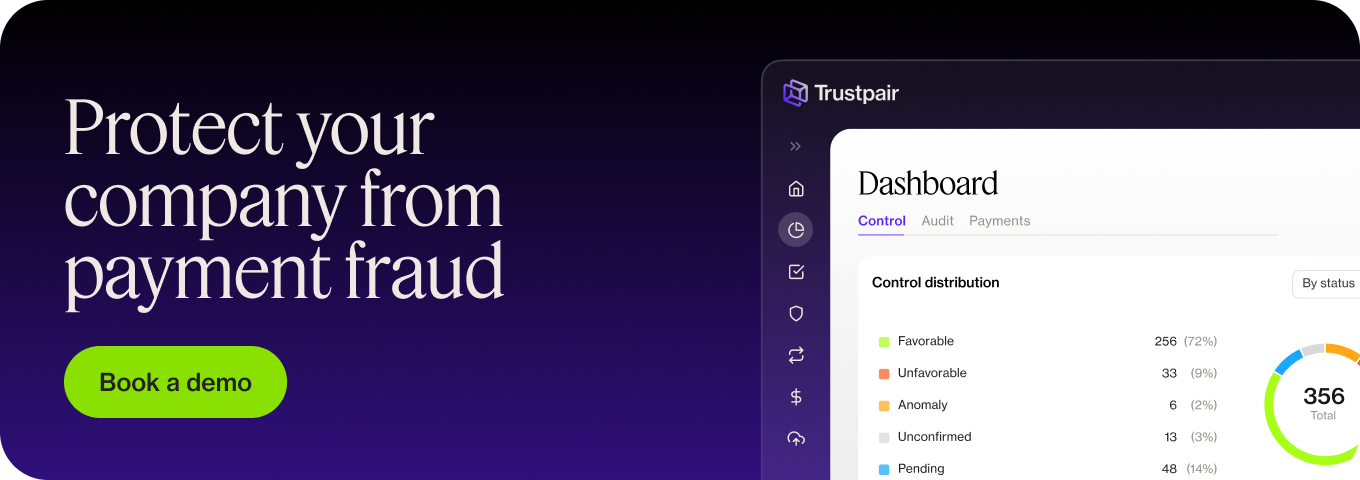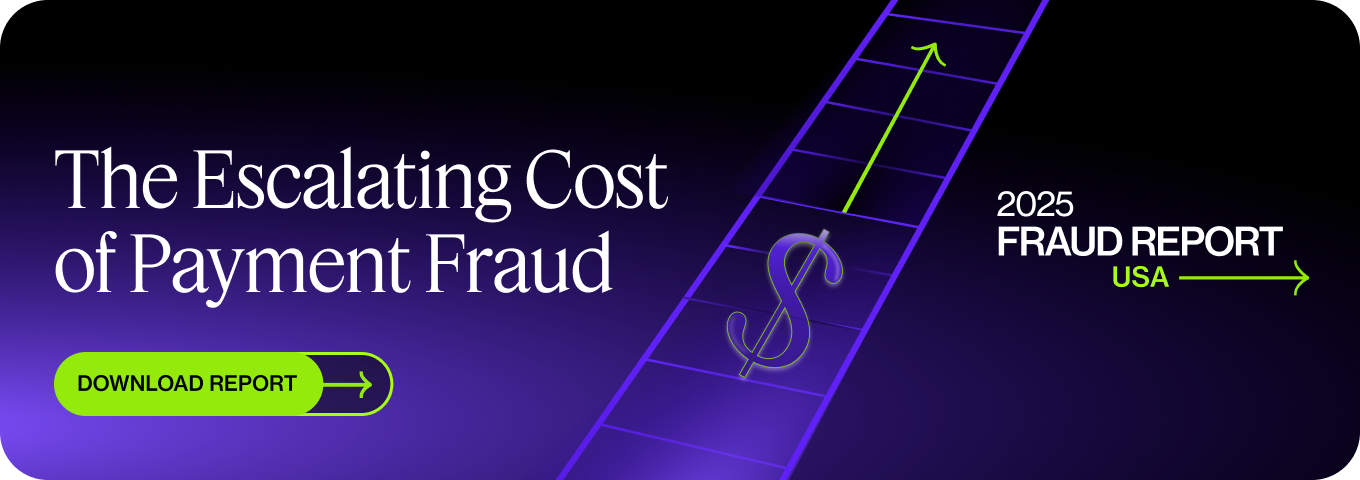Last year, 12% of companies were targeted by 10 or more attempts of payment fraud in the US. But fraud risk management isn’t just about controlling payment fraud, it’s channels like email scams, wire transfer frauds, and vendor frauds, too.
But the impact of fraud lasts for years. On top of financial damages, your organization is branded by the scarlet letter, affecting your ability to attract future clients and investors.
Trustpair is the ultimate fraud risk management tool, blocking fraud by controlling supplier data before payments are made. Contact an expert right away!
What is fraud risk management and why is it crucial?
Many companies already think they have the right plans to evaluate and respond to threats. But risk identification (in your fraud risk management strategy) needs to be stronger. Because despite confidence in anti-fraud measures, the truth is that fraud continues to affect businesses. Over $660 million was lost by businesses to impersonation scams, like vendor fraud, alone.
Falling victim to these crimes leads to significant financial and reputational consequences. So it’s clear that organizations can’t place their whole trust in the current strategies and require a stronger protocol.
Fraud, an increasing concern for companies
Fraud risk management is essential to the running of any business because it:
- Increases fraud awareness and informs your team members about common internal and external threats
- Identifies risks and ensures they are continuously monitored
- Defines the investigation process when businesses are at risk levels
But more importantly, risk management is crucial because the threat of fraud is growing. 43% of US companies have been targeted by two or more attempts of fraud within the last 12 months, and the threats show no signs of slowing down. With swathes of new types of fraud emerging (think fake job adverts and fraudulent business schemes), employees are crippled by trying to fend off fraudsters from all angles.
Instead, a fraud risk management framework can put things into perspective and help your team relax in the workplace by knowing that the risk of fraud is controlled and fraud mitigation strategies are in place.
Fraud risk management, a definition
Fraud risk management defines the process for spotting and evaluating risks of fraud. A good fraud risk framework will outline the threats, prioritize them and develop proper response protocols. The overview should also indicate the business controls in place that reduce the risk of fraud occurring.
What are the best practices of fraud risk management?
When talking about fraud risk management best practices, there are five key considerations:
- Fraud risk governance
- Fraud risk assessment
- Fraud prevention
- Risk detection mechanisms
- Risk monitoring and reporting
Let’s explore examples for each factor, and how you can apply the best practices in your business.
Fraud risk governance
Managing risk is about the governance controls in place to prevent fraud within your organization. Governance looks at your daily systems through the perspective of fraud – what anti-fraud protocols and measures do you have in place?
The Enron Accounting scandal (2002) exposed several failings in US business governance practices. After the fallout, the Sarbanes-Oxley Act (SOX Law) was introduced to provide order and guidance in terms of fraud risk governance. It led to better transparency through enforced financial reporting, certifications for senior leadership, and more robust internal controls.
You can apply best practices like internal controls to your business through policies such as the segregation of duties. Also known as the 4 eyes principle, it separates different finance functions to several members of staff. It ensures that no one role is completed by a single person, unchecked. Therefore, the segregation of duties protects the company from risks of internal fraud.
Fraud risk assessment
A fraud risk assessment allows your finance team to identify all of the potential risks to the business. Moreover, the risk analytics assessment evaluates the likelihood of each risk happening, and the impacts.
Examples of risks include:
- Third-party risks: the actions of vendors, suppliers, and partners can impact your operations and level of business risk
- Operational risks: your systems and internal processes affect the running of the business (the threat of cyber attacks)
- Governance risks: being non-compliant with regulations is not an option
- Credit risks: extending credit to customers places a high-risk burden on your business
- Enterprise risks: decision-makers can change the reputation of the company, impacting the risk assessment
Satyam Computer Company Ltd fell victim to internal corporate fraud, partially due to inadequate risk assessments. In 2009, the company’s CEO admitted to inflating and overstating quarterly profits for over ten years (in the case of CEO fraud).
One of the biggest factors that contributed to the fraudsters getting away with it for so long, was a lack of due diligence. Without following a risk assessment, auditors failed to properly investigate the financial statements. Plus, by allowing the CEO full control over creating financial statements, there was no way of mitigating the risks by a ‘segregation of duties’ to verify his work.
Fraud prevention
Fraud prevention tools protect your business against the risks of fraud. Tools can work in tandem to secure different parts of your business, such as payments or financial records.
For example, machine learning technology allows your finance department to predict trends in behavior. In particular, machine learning technology can use pattern recognition to spot suspicious activity. This can help you identify anomalies in customer behavior, for example. Machine-learning technology can also reveal false positives.
Likewise, real-time monitoring can protect your company in its enterprise risk management strategy. Vendor fraud can occur when impersonators intercept your communications and send an invoice with their account details on it. With real-time monitoring, your system can detect the change and authenticate the real account details. Companies like Trustpair work in fraud prevention by blocking these payments from going through, effectively securing your business against fraudsters.
Learn more about fraud prevention in b2b companies by downloading our latest report on payment fraud.
Risk detection mechanisms
Risk detection, similar to overall fraud detection, refers to the identification of emerging hazards. Implementing risk detection mechanisms in your risk management solutions can replace the human element of fraud risks – since you can introduce them automatically.
Here are some examples of risk detection mechanisms:
- Risk deviation
- Data Analytics
- Data verification
Risk Deviation
When completing your risk assessment, you can calculate the current levels of risk per third-party partner. By setting a range for deviation (known as risk appetite) your finance team will know when the level of risk exceeds a comfortable value.
For example, if a partner’s CEO commits a crime, the risk of being associated with the partner is heightened. If this goes above the stated range, you’ll have the means to end the partnership without emotional bias, to protect your own company.
Data Analytics
Data analytics allows you to compare historical data with current trends. When detecting risks, this can be helpful to add confidence, since it backs up strategic decision-making with hard information.
Data analytics played a huge part in Target’s fraud detection back in 2013. After a cybersecurity breach successfully occurred, Target’s data analytics program tracked customer transactions. When weird patterns of purchasing were detected, red flags were raised. Target’s analytics team identified the breach very quickly and was able to mitigate the losses.
Data verification
Data verification refers to the authentication of your information. In theory, more data is better but you need to make sure it’s accurate – otherwise managing the fraud risks becomes harder.
Trustpair’s platform facilitates fraud risk management by verifying your vendor data. Our databases span global jurisdictions to authenticate and gain insights on three types of data:
- Company information (including the name, address, and whether it appears on blacklists)
- Location information (including country information and whether it appears on blacklists)
- Banking information (including matching account details and suspicious activity)
Through data verification, we’ve been able to prevent 100% of fraud attempts on behalf of clients. Demo Trustpair’s fraud prevention platform to be proactive and secure your business against the risks of fraud.
Risk monitoring and reporting
Risk monitoring and reporting is a crucial part of the fraud risk management program since it helps you to evaluate how well it’s going. Reporting allows you to consider previous actions, investigate breaches and identify ongoing or emerging risks.
This is the final step in your fraud risk management process since it holds team members accountable and informs you of your next steps. With Trustpair, you can digitize different financial processes (such as reporting) and automate processes within the p2p system. Ensuring your risk manager can turn their focus away from time-consuming tasks, and towards adding value back to the business.
To conclude…
Fraud risk management strategies protect your business against threats of fraud. Assessing risk and fraud is important, as is developing a governance framework to remain in control. Reducing your risk exposure can be done through fraud prevention, risk detection, monitoring, and reporting.






